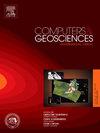Seismic random noise suppression by structure-oriented BM3D
IF 4.2
2区 地球科学
Q1 COMPUTER SCIENCE, INTERDISCIPLINARY APPLICATIONS
引用次数: 0
Abstract
Random noise affects the precision of seismic imaging and interpretation, thus denoising is a significant step in data processing. Block matching and 3D collaborative filtering (BM3D) is an effective block-based noise suppression algorithm. However, when it is applied to the data with complex structures, the similarity between data blocks will decrease significantly, thereby damaging some structural details and leading to energy leakage. To address this issue, we propose a structure-oriented BM3D (SBM3D) denoising method. Initially, plane wave destruction (PWD) is employed to estimate the local slope of the seismic data. Using the obtained slope information, the events are flattened, significantly enhancing the similarity between data blocks. To minimize the flattening error, segmented flattening of the data is performed. Subsequently, BM3D is applied to the flattened data for denoising. Finally, the events are restored to their original shape through inverse flattening to obtain the ultimate denoised result. Through this method, the leaking signal energy from removed noise can be reduced. In addition, we adopt a parallel computing method to improve the computational efficiency. Synthetic and field data testing results show that this improved method can effectively reduce signal damage while ensuring the denoising effect.
面向结构的BM3D地震随机噪声抑制
随机噪声影响地震成像和解释的精度,因此去噪是数据处理中的一个重要步骤。块匹配和三维协同滤波(BM3D)是一种有效的基于块的噪声抑制算法。然而,当它应用于结构复杂的数据时,数据块之间的相似性会显著降低,从而破坏一些结构细节,导致能量泄漏。为了解决这个问题,我们提出了一种面向结构的BM3D (SBM3D)去噪方法。最初,采用平面波破坏(PWD)估计地震资料的局部斜率。利用得到的斜率信息,对事件进行平面化处理,显著提高了数据块之间的相似性。为了使平坦化误差最小化,对数据进行分段平坦化。然后,利用BM3D对数据进行去噪处理。最后,通过逆平坦化将事件恢复到原始形状,得到最终去噪结果。通过这种方法,可以降低去除噪声后的信号能量泄漏。此外,我们采用并行计算的方法来提高计算效率。综合和现场数据测试结果表明,改进后的方法在保证去噪效果的同时,能有效降低信号损伤。
本文章由计算机程序翻译,如有差异,请以英文原文为准。
求助全文
约1分钟内获得全文
求助全文
来源期刊

Computers & Geosciences
地学-地球科学综合
CiteScore
9.30
自引率
6.80%
发文量
164
审稿时长
3.4 months
期刊介绍:
Computers & Geosciences publishes high impact, original research at the interface between Computer Sciences and Geosciences. Publications should apply modern computer science paradigms, whether computational or informatics-based, to address problems in the geosciences.
 求助内容:
求助内容: 应助结果提醒方式:
应助结果提醒方式:


